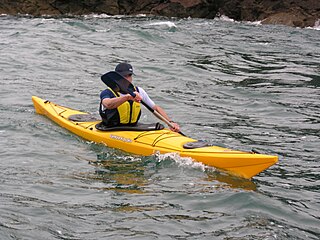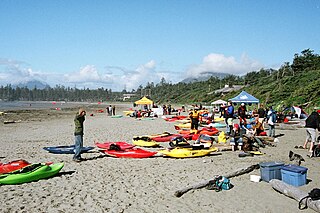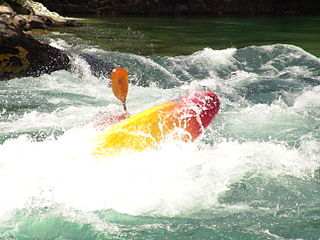 W
WKayaking is the use of a kayak for moving across water. It is distinguished from canoeing by the sitting position of the paddler and the number of blades on the paddle. A kayak is a low-to-the-water, canoe-like boat in which the paddler sits facing forward, legs in front, using a double-bladed paddle to pull front-to-back on one side and then the other in rotation. Most kayaks have closed decks, although sit-on-top and inflatable kayaks are growing in popularity as well.
 W
WCas and Jonesy are an Australian duo known for being explorers, endurance athletes, motivational speakers, as well as a writer and documentary producer respectively. Their given names are James John Castrission and Justin Roderick Jones.
 W
WCreeking is a branch of canoeing and kayaking that involves descending very steep low-volume whitewater. It is usually performed in specialized canoes and kayaks specifically designed to withstand the extreme whitewater environment in which the activity occurs. In addition, the canoes and kayaks give the paddler improved performance and maneuverability needed to avoid river obstacles.
 W
WThirty years after the first person rowed solo across the Tasman Sea in 1977, Crossing the Ditch was the effort of Justin Jones and James Castrission, known as Cas and Jonesy to become the first to cross the sea and travel from Australia to New Zealand by sea kayak. Setting off from Forster, New South Wales on 13 November 2007 in their custom-designed kayak Lot 41, the two-man expedition succeeded after previous attempts, including the fatal journey of Andrew McAuley, had been unsuccessful. They arrived at Ngamotu Beach, in New Plymouth, New Zealand on 13 January 2008.
 W
WKayak fishing is fishing from a kayak. The kayak has long been a means of transportation and a means of accessing fishing grounds. Kayak fishing has gained popularity in recent times.
 W
WKayaking at Kotepally is a sports activity at the Kotepally Dam, which is located about 20 km away from the famous Vikarabad hills. On 24/02/2016, The government of Telangana, Irrigation & CAD Department issued a government order numbered G.O.RT.No. 198 stating that government have accorded permission to the Engineer-in-Chief (Irrigation), Hyderabad to introduce water sports and skills development programs at Kotpally Project to promote tourism and create employment opportunities for the local youth and considered Matsyakara Yuvajana Sangam of Kotpally Vagu Project of Progressive Telangana Foundation (PTF) for taking up boating activities.
 W
WProtests against Arctic drilling began in Seattle in 2015 in response to the news that the Port of Seattle authority made an agreement with Royal Dutch Shell to berth offshore drillships and semi-submersibles at the Port's Terminal 5 (T5) during the off-season of oil exploration in Alaskan waters of the Arctic. Hundreds of protesters took to Elliott Bay in kayaks, rafts, and other small boats, both as a demonstration and to interrupt docking of Shell's Polar Pioneer semi-submersible drilling vessel at Terminal 5. The waterborne demonstrators were dubbed kayaktivists by social and news media.
 W
WIn kayaking, a playspot is a place where there are favorable stationary features on rivers, in particular standing waves, 'holes' and 'stoppers', where water flows back on itself creating a retentive feature, or eddy lines.
 W
WThe Scottish Canoe Association is the national governing body for canoeing, kayaking and other paddlesport in Scotland.
 W
WA sea kayak or touring kayak is a kayak developed for the sport of paddling on open waters of lakes, bays, and the ocean. Sea kayaks are seaworthy small boats with a covered deck and the ability to incorporate a spray deck. They trade off the maneuverability of whitewater kayaks for higher cruising speed, cargo capacity, ease of straight-line paddling, and comfort for long journeys.
 W
WSnow boating or snow kayaking is a somewhat newer winter sport typically done by kayakers. It usually involves kayakers descending snow slopes, in contrast to river sports such as whitewater kayaking for which the boats were usually designed. Snow boating is typically done in the backcountry and occasionally at resorts and ski areas. Races are held in a modus similar to those of snowboarding they are known as a boatercross. In the races, kayakers race to a finish line or point.
 W
WSprint kayak is a sport held on calm water. The paddler is seated, facing forward, and uses a double-bladed paddle pulling the blade through the water on alternate sides to propel the boat forward. Kayak sprint has been in every summer olympics since it debuted at the 1936 Summer Olympics. Racing is governed by the International Canoe Federation.
 W
WSquirt boating is a form of whitewater kayaking or canoeing where the boat is designed to be as low in volume as possible while still allowing the paddler to float. Squirt boats are designed to use both surface and underwater currents to manoeuvre within the water. These manoeuvres can be used to effect navigational control or to perform tricks.
 W
WSurf kayaking is the sport, technique, and equipment, used in surfing ocean waves with kayaks. Surf kayaking has many similarities to surf board surfing, but with boats designed for use in surf zones, and with a paddle. A number of kayak designs are used, but all are aimed at better using the waves to propel the craft.
 W
WA surfski is a type of kayak in the kayaking "family" of paddling craft. It is generally the longest of all kayaks and is a performance oriented kayak designed for speed on open water. The distinguishing characteristic of a surfski is that it is primarily used for performance paddling in open water, most commonly the ocean, although it is well suited to all bodies of water and recreational paddling. The most common use of surfskis is in surf lifesaving competitions and downwind paddling.
 W
WWhitewater kayaking is a recreational outdoor activity which uses a kayak to navigate a river or other body of whitewater or rough water.